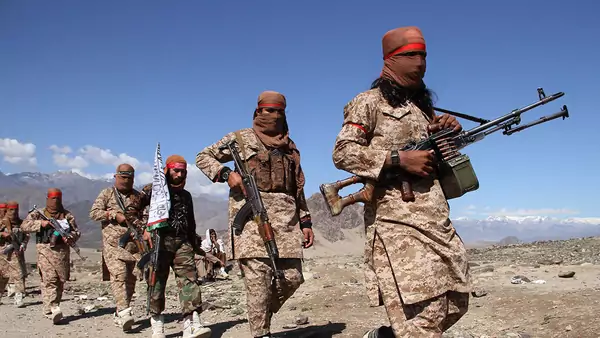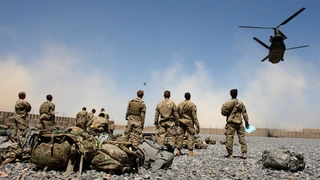by Lindsay Maizland and Zachary Laub
The Taliban is a predominantly Pashtun, Islamic fundamentalist group that ruled Afghanistan from 1996 until 2001, when a U.S.-led invasion toppled the regime for providing refuge to al-Qaeda and Osama bin Laden. The Taliban regrouped across the border in Pakistan and has led an insurgency against the U.S.-backed government in Kabul for more than eighteen years.
Experts say the Taliban is stronger now than at any point in recent memory, controlling dozens of Afghan districts and continuing to launch attacks against both government and civilian targets. An agreement signed by U.S. President Donald J. Trump’s administration and the Taliban in early 2020 could mark a new stage for the militant group as it starts intra-Afghan negotiations on Afghanistan’s future.
How was the Taliban formed?
The Taliban was formed in the early 1990s by Afghan mujahideen, or Islamic guerilla fighters, who had resisted the Soviet occupation of Afghanistan (1979–89) with the covert backing of the CIA and its Pakistani counterpart, the Inter-Services Intelligence directorate (ISI). They were joined by younger Pashtun tribesmen who studied in Pakistani madrassas, or seminaries; taliban is Pashto for “students.” Pashtuns comprise a plurality in Afghanistan and are the predominant ethnic group in much of the country’s south and east. They are also a major ethnic group in Pakistan’s north and west.
The movement attracted popular support in the initial post-Soviet era by promising to impose stability and rule of law after four years of conflict (1992–1996) among rival mujahideen groups. The Taliban entered Kandahar in November 1994 to pacify the crime-ridden southern city, and by September 1996 seized the capital, Kabul, from President Burhanuddin Rabbani, an ethnic Tajik whom it viewed as anti-Pashtun and corrupt. That year, the Taliban declared Afghanistan an Islamic emirate, with Mullah Mohammed Omar, a cleric and veteran of the anti-Soviet resistance, leading as amir al-mu’minin, or “commander of the faithful.” The regime controlled some 90 percent of the country before its 2001 overthrow.
The Taliban imposed a harsh brand of justice as it consolidated territorial control. Taliban jurisprudence was drawn from the Pashtuns’ pre-Islamic tribal code and interpretations of sharia colored by the austere Wahhabi doctrines of the madrassas’ Saudi benefactors. The regime neglected social services and other basic state functions even as its Ministry for the Promotion of Virtue and Prevention of Vice enforced prohibitions on behavior the Taliban deemed un-Islamic. It required women to wear the head-to-toe burqa, or chadri; banned music and television; and jailed men whose beards it deemed too short.
How did the world respond to the Taliban’s rise?
The regime was internationally isolated from its inception. Only Saudi Arabia, the United Arab Emirates, and Pakistan recognized the government. Many analysts say Islamabad supported the Taliban as a force that could unify and stabilize Afghanistan while staving off Indian, Iranian, and Russian influence.
Two UN Security Council resolutions passed in 1998 urged the Taliban to end its abusive treatment of women. The following year the council imposed sanctions on the regime for harboring al-Qaeda. Omar granted al-Qaeda sanctuary on the condition that it not antagonize the United States, but bin Laden reneged on their agreement in 1998 when he orchestrated bombings of U.S. embassies in East Africa. The Taliban was further ostracized following its destruction of two giant Buddha statues in Bamiyan, Afghanistan, in March 2001. A UN General Assembly resolution called on the Taliban to protect the country’s cultural heritage.
After al-Qaeda operatives attacked the United States on September 11, 2001, Omar rejected U.S. demands that he give up bin Laden. U.S. forces invaded Afghanistan in October 2001, and the Taliban was quickly overthrown. Omar and many of his top aides escaped to the frontier territories of Pakistan. From there, the Taliban waged an insurgency against the U.S.-backed Afghan government. The group is now under investigation in the International Criminal Court for alleged abuses of Afghan civilians, including crimes against humanity, carried out since 2003. U.S. and Afghan forces are also being investigated for alleged war crimes.
The U.S. War in Afghanistan
Who leads the Taliban?
Analysts believe that the Taliban leadership, primarily based outside the country, continues to maintain control over its fighters and officials throughout Afghanistan. In its 2019 report [PDF], the UN Taliban monitoring team said that “the Taliban leadership has managed to maintain the group’s overall unity,” despite Washington’s targeted killing of some senior leaders and the start of negotiations with the United States.
The leadership council is called the Rahbari Shura and is better known as the Quetta Shura, named for the city in Pakistan where Omar and top aides are believed to have taken refuge after the U.S. invasion. The council makes decisions for all “political and military affairs of the Emirate,” according to the UN monitor. It is currently led by Mawlawi Haibatullah Akhundzada. (Omar died in 2013 and was succeeded by Mullah Akhtar Mohammad Mansour, who was killed in a 2016 U.S. air strike in Pakistan.) The leader is supported by deputies, currently Mullah Muhammad Yaqoub, Omar’s son, and Sirajuddin Haqqani, who is also acting head of the Haqqani Network, a militant group in Afghanistan’s southeast and Pakistan’s northwest with close ties to the Taliban, al-Qaeda, and Pakistan’s ISI.
The leadership council oversees nine commissions, similar to the ministries in place prior to the Taliban’s overthrow, and three administrative organs through which the Taliban operates a shadow government. The commissions focus on areas including economics, education, health, and outreach. The military commission appoints shadow governors and battlefield commanders for each of Afghanistan’s thirty-four provinces. The political commission, headed by Taliban cofounder Mullah Abdul Ghani Baradar, has been leading negotiations with the United States and is based in Doha, Qatar.
How strong is the Taliban?
The Taliban has withstood counterinsurgency operations from three U.S. administrations in a war that has killed more than 2,400 Americans [PDF] and 1,100 NATO troops. More than 43,000 civilians have died, and an estimated 45,000 Afghan troops and police officers were killed just in the past five years.
Despite the Taliban’s own losses, estimated to be in the tens of thousands, experts say the group is stronger now than at any point in the last eighteen years. With an estimated sixty thousand full-time fighters, it controls many of the country’s 398 districts. In early 2020, the Taliban controlled an estimated 18 percent of districts, while the government controlled 33 percent, according to the Foundation for Defense of Democracies Long War Journal, a U.S.-based publication that has covered the U.S. fight against al-Qaeda and other militant groups since 2007. The rest of the country was contested by both groups.
The UN Assistance Mission in Afghanistan (UNAMA) documented 10,392 civilian deaths and injuries [PDF] in 2019. In July of that year, more civilians died than in any other month since UN reporting began in 2009. UNAMA attributed a majority of these casualties to insurgents, including the Taliban, who deliberately targeted civilians or used such indiscriminate tactics as improvised explosive devices; other civilians were caught in the crossfire between insurgents and government forces. Air strikes, a majority by international military forces, also caused civilian casualties.
What is the state of the Taliban’s finances and international support?
The Taliban’s primary sources of revenue are opium poppy cultivation and narcotics, with a UN report [PDF] estimating that it earned $400 million in 2018 from the illegal drug trade. It also levies taxes on commercial activities in its territories, such as farming and mining. It has supplemented its income with illicit mining, the extortion of local businesses, and donations from abroad, despite strict UN sanctions.
Many experts say the Pakistani security establishment continues to provide Taliban militants sanctuary in the country’s western tribal areas to try to counter India’s influence in Afghanistan. Islamabad dismisses these charges. (At the same time, Pakistan has battled its own insurgency group, Tehrik-e-Taliban Pakistan, commonly known as the Pakistani Taliban, which is distinct from the Afghan group.)
The Taliban is believed to still have strong ties with al-Qaeda, according to a 2020 UN report. The Taliban provides al-Qaeda with protection in exchange for resources and training. Al-Qaeda has up to six hundred fighters in Afghanistan, mostly in several eastern provinces, according to the UN report. But its central leaders, including Ayman al-Zawahiri, are believed to be hiding in Pakistan. The Taliban has also fought the self-proclaimed Islamic State, which is a rival of al-Qaeda and has an estimated 2,500 members in Afghanistan.
Do Afghans support the Taliban?
For years after its fall from power, the Taliban enjoyed support. The U.S.-based nonprofit organization Asia Foundation found in 2009 [PDF] that half of Afghans—mostly Pashtuns and rural Afghans—had sympathy for armed opposition groups, primarily the Taliban. Afghan support for the Taliban and allied groups stemmed in part from grievances against public institutions.
But in 2019, a response to the same survey found only 13.4 percent of Afghans had sympathy for the Taliban [PDF]. As U.S.-Taliban peace talks gained momentum, a vast majority of Afghans said they supported a peace process and 64 percent believed reconciliation with the Taliban was possible.
What’s next for the Taliban?
In February 2020, the United States and the Taliban signed an agreement [PDF] to set a path to peace after more than eighteen years of war. The agreement includes a significant withdrawal of U.S. troops from Afghanistan and guarantees that the Taliban will not provide a safe haven for terrorists. It also calls for the start of negotiations on Afghanistan’s future between the Taliban and the Afghan government, which was largely sidelined during U.S.-Taliban talks.
Many issues would need to be resolved during intra-Afghan discussions, including how power will be shared with the Taliban, what will happen to Afghanistan’s democratic institutions and constitution, and how women’s rights will be protected. Questions also remain over whether Taliban fighters will be disarmed and reintegrated [PDF] into society and who will lead the country’s army. The Taliban wants to establish an Islamic government in Afghanistan, ideally as an emirate, which would be led by a religious leader and draw its legitimacy from clerics. Afghanistan is currently an Islamic republic, which is led by a president and draws legitimacy from universal suffrage and accordance with international laws and norms.
Analysts disagree on the Taliban’s motives and what the group seeks from intra-Afghan negotiations. Some experts and Afghans fear that the U.S.-Taliban agreement was just an attempt to remove U.S. forces from Afghanistan and that it could spark a new conflict that would eventually allow the Taliban to regain control. For the Taliban, “peace doesn’t mean an end to the fighting, it means an end to the U.S. occupation,” says Bill Roggio, an editor for Long War Journal. “After the United States is gone, the Taliban will work to settle its scores and reestablish the Islamic emirate.”


No comments:
Post a Comment